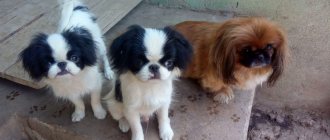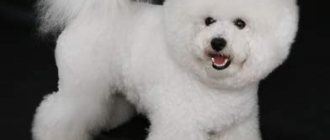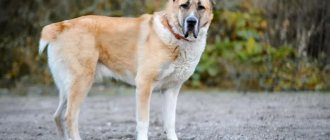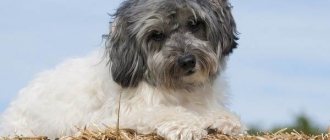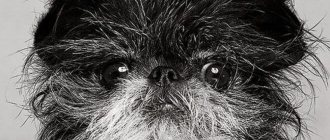Origin story
The history of the appearance of this breed is unusual. The ancestors of Cotons in their modern form are the Maltese, a breed of dog that gained enormous popularity among seafarers several thousand years ago. These dogs were excellent rat hunters, so sailors took them with them on voyages to protect food. And with the expansion of maritime trade routes, some of the dogs began to remain in other countries and became popular on many continents.
One day this dog was adopted by the royal family from Madagascar, which later led to the mixing of the Maltese's blood with other dogs from the island. This event led to the emergence of a new, unusual, good-natured breed of dog - the Coton de Tulear. The name was formed due to the origin (Tulear is a port in Madagascar) and the characteristics of the wool (cotton-cotton). Thus arose the breed, literally translated as cotton from Tulear.
History of the breed: Madagascar or France?
The history of this breed goes back to the distant island of Madagascar in the port of Tulear. There is a legend that the ancestors of these dogs were Maltese dogs that were on shipwrecked French ships.
They were taken on voyages for their excellent hunting qualities, which helped in the fight against ship rats.
Breeds such as the Russian-European Laika, Parson Russell Terrier, Shiba Inu, Beagle, Basset Hound, Irish Setter, and Flat are also distinguished by good hunting qualities.
Later, Maltese dogs were crossed with local island dogs to produce small, fluffy, and energetic dogs.
However, there is another version, according to which the Maltese lap dogs arrived in Madagascar not with sailors, but with the French colonialists.
Representatives of the breed arrived on the European continent not so long ago - in the 60s of the last century. And they immediately attracted the attention of not only professional dog breeders, but also amateurs.
Their small size, lively mind and attractive appearance have made these dogs excellent companions for many noble people on trips and outings. Moreover, they emphasized the status of the owner and added elegance to his image.
This increased interest contributed to the rebirth of the breed and its widespread distribution.
The Madagascar Bichon is considered a type of lapdog. The word "lapdog" comes from the name of the Italian city of Bologna. But in the Russian Empire the French lapdog was called the Bolognese breed, since it was brought from France.
The breed was recognized by the Fédération Cynologique Internationale in 1970, at which time its strict standards were spelled out and a melodious name was given - Coton de Tulear.
Did you know? Unlike people, dogs can hear ultrasonic whistles well. Having learned this, Paul McCartney inserted such a sound into one of the songs especially for his dog.
Description of the breed
The description of this dog begins with a characteristic feature of the breed: its coat is similar to silk or cotton due to its softness, which is traditionally white in color. The dog's height at the withers reaches no more than 35 cm, and its weight is about 5-7 kg. Despite its miniature size, the pet has a strong body and exhibits constant physical activity.
The breed standard also implies:
- triangular head;
- round, deep-set eyes;
- thin, drooping ears;
- oblong body;
- muscular neck, strong chest;
- the tail is long and set low.
Based on the characteristics of the elongated body, experts find its similarity to a dachshund.
External data of Coton de Tulear
- height at withers – up to 33 cm;
- weight – up to 7 kg;
- size – the breed is classified as a dwarf dog;
- general characteristic is a strong and hardy pet that is constantly active and loves to swim. It has harmonious body proportions and a snow-white coat, which is a key feature of the breed;
- the head is triangular in shape, short, the skull is rather convex, the transition from the forehead to the nose is weakly expressed, the tip of the nose is dark in color;
- eyes are round in shape, set quite deep, set wide apart, as a rule, have dark shades, although there are also light colors (this is unacceptable for taking part in an exhibition);
- The ears are thin, set high, of medium length, hang down and fit tightly to the dog’s cheeks. Covered with snow-white fur, speckling of other colors is allowed;
- body - stretched shape, reminiscent of the structure of a dachshund, squat body, muscular neck, no dewlap, wide chest with pronounced ribs, straight back, slightly convex loin, large and wide croup;
- limbs – well-developed paws with strong muscles, short limbs, toes gathered into a ball, pads clearly visible;
- tail - has a thick base, which thins evenly towards the end, is set low, and in a calm state takes a lowered position, below the hock joint. The tail has an impressive length - more than 17 cm;
- wool – long fluffy coat, with slight waviness;
- color – traditionally dogs have a solid white color. Smokey spots are allowed, in most cases on the ears.
Psychological picture
The breed has a whole set of positive qualities: they are obedient, easy to train, friendly, responsive, smart, devoted to their owner, active and cheerful. Despite their pretty appearance, these dogs are very resourceful and enterprising. Coton de Tulear are responsible guards and can be trusted to protect property and homes.
The breed is extremely peaceful, loves company and active games. Dogs have an interesting feature - when playing, they often jump, lifting all four paws off the ground at the same time. You can watch their behavior endlessly; pets always make you smile and lift your spirits.
The main disadvantage of the breed is its pathological intolerance to loneliness. Dogs literally go crazy when they are alone with themselves. At the same time, the company of other animals will not replace human attention. To solve the problem, it is recommended to take Coton de Tulear with you as often as possible. Moreover, the size and docile nature allows the dog to accompany the owner almost everywhere without causing trouble.
The breed is well suited for keeping with the family, where it will always receive the attention of one of the household members. Coton de Tulear are very observant, they quickly understand the rules of living in the house and willingly follow them. Pets respect a person’s personal space and will not be overly intrusive. If the owner is busy, the Coton de Tulear will lie down nearby, patiently waiting for you to be free.
In the house, pets, like cats, strive to take an advantageous position and watch what is happening from above. They often climb onto sofas, tables and even cabinets. The higher they can climb, the more comfortable they will feel.
The pet shows some mistrust of strangers, warily examining them before “approving” the visit and showing hospitality. The Coton de Tulear warns of danger with a loud, loud bark and is always on guard.
The dog tends to show aggression towards other animals, so it needs early socialization lessons. The animal is extremely friendly towards children and loves to participate in fun games. A bond and attachment quickly develops between babies and Coton de Tulear.
Breed-specific diseases:
- heart failure;
- liver problems;
- back diseases;
- cataract;
- urolithiasis disease;
- fungal diseases.
The Coton de Tulear is a purebred breed, which is why the dog's gene pool is very scarce. This leads to the occurrence of hereditary diseases. Fortunately, they appear extremely rarely. Out of 100 Coton de Tulear puppies, only 1 may be at risk for an inherited disease. These statistics are very optimistic.
Character
The character of Cotons includes a considerable number of positive qualities. Dogs are kind and show devotion to their owner. Thanks to their obedience and intelligence, they are easy to train. Given their size, they are courageous and will always be ready to protect their guardian or his property, acting as a guard.
They love cheerful company and active games. But there is also a minus in this regard - dogs are absolutely not intended for a lonely life without the attention and care of a person. Therefore, with this character trait, Coton de Tulear is most suitable for living in large families that can satisfy its craving for human attention. He himself is also capable of bringing happiness to all family members, thanks to his good nature.
Care and maintenance
The Coton de Tulear is suitable for keeping at home. The small size of the animal makes it easy to allocate a place for it in the house, which will not bring difficulties to its residents. Despite the presence of a fluffy white fur coat, the pet sheds very imperceptibly; fallen hairs do not cause problems with cleaning the home, as they remain in the dog’s fur.
A distinctive feature of this breed is the absence of a pungent odor inherent in most domestic dogs, which becomes another advantage in keeping it.
To maintain a positive attitude in your pet, you need to set aside at least half an hour every day to play with him, as cats love active games. A lack of active life can lead to negative consequences and a deterioration in the dog’s well-being.
Feeding
Puppies of this breed require soft food or fluids rich in protein and calcium to develop a strong and strong body. You should feed 4 times a day, but do not leave the plate at the feeding site. It is better to pick her up after 20 minutes, which will teach the puppy to the correct regime.
It is recommended to switch to solid food in the second month after birth, and to food for adult dogs at 8-9 months, while reducing the number of meals to 2 times a day. The pet's menu should include vegetables, fruits, meat, fish, so that the sensitive body can receive the necessary vitamins and nutrients from natural products.
Veterinary
Competent veterinary support throughout life is especially important for the Coton de Tulear - this will allow you to notice unpleasant symptoms in time and stop them.
Diseases and vaccinations
Unsystematic and sometimes incorrect breeding and often spontaneous selection of sires have done a disservice to this wonderful breed. Along many lines of Cotons there is a whole chain of hereditary diseases, including:
- heart failure;
- liver dysfunction;
- deafness;
- cataracts and retinal atrophy;
- urolithiasis disease;
- arthritis and luxation of the kneecap;
- problems with the spine;
- fungal infections;
- allergy.
The breeding of Cotons de Tulear used a limited gene pool, which caused some problems
It is encouraging that manifestations of genetic diseases are still extremely rare. Recent statistics show that only one percent of modern Coton offspring are susceptible to genetic diseases. The breed's internal potential and its ability to heal itself are very high, which allows us to make optimistic forecasts.
Comprehensive vaccination of Cotons is done according to the usual scheme for all breeds of dogs: in puppyhood - at 8 and 12 weeks, in adults - annually; The first rabies vaccination is at three months, all subsequent ones are once a year. Before vaccination, the dog must be healthy and free from parasites, after which it must undergo at least a week’s quarantine (do not communicate with other animals).
In an interesting position
As already mentioned, Cotons adore children, both human and their own. Not only the happy mother, but also all members of the flock will take whatever part they can in raising the younger generation. This is extremely interesting to watch.
The relationship in the Coton family is very touching.
Pregnancy and childbirth for a Coton de Tulear female is a responsible and difficult process, as for all decorative breeds. The likelihood of complications is not too high, but it does exist. Therefore, you should always arrange in advance with an experienced veterinarian so that he is ready at the “X” hour - you may have to perform a caesarean section.
During pregnancy, feed the bitch very well, but in no case overfeed, this can complicate the birth process. Puppies are usually born very small, there are three to six in a litter. Let's give the overly caring mother a break and periodically distract her from the kids. Well-fed puppies will sleep well in a warm box even without it, and the bitch needs at least a short walk several times a day and eat normally in order to quickly restore strength.
White Coton puppies are born spotted
Video: hello, it's us
Training and education
Proper raising of Cotons brings satisfaction to both the owner and his ward. The pet is very smart and can easily be taught commands and even tricks. At exhibitions, Cotons show amazing results in following learned commands, as well as in obstacle racing. The best training method is rewarding. After correctly completed tasks, the pet should receive any treat, which will stimulate him to learn even more willingly.
The Coton de Tulear should not be subjected to harsh training methods. This can have a detrimental effect on his character and psyche.
Diseases and life expectancy
The dog's gene pool is quite small, which is why pets are susceptible to hereditary diseases - heart failure or liver problems. However, as statistics show, 1 puppy out of 100 suffers from hereditary diseases. Compared to other similar breeds, this ratio is a good indicator.
In addition to the above, Cotons may suffer from:
- cataracts;
- fungal infections;
- urolithiasis.
The average life expectancy is 12-14 years, which is a good indicator for decorative dogs.
Nutrition and proper care
Initially, it is necessary to take into account that the breed is decorative, and therefore needs special nutrition. However, the choice of food or natural products always remains with the owner.
If you opt for natural food, then you should choose only high-quality fresh products and monitor the balance of nutrients and nutrients.
A dog's diet must include meat, fish, cereals, vegetables and other healthy foods. Be sure to prepare fresh food and avoid feeding your dog heated foods. If the pet has not finished the portion, it should not be left for the next feeding. The dog must also have constant access to fresh water, which is also very important.
If you feed your pet natural food and do not check its freshness, this can cause very severe poisoning of the pet. This is due to the fact that the Coton’s stomach is very sensitive and reacts to the slightest staleness.
If the diet contains any useful substances, this will immediately affect the condition of the dog’s coat. Thus, a balance of vitamins and minerals is mandatory.
As for the features of proper care, the difficulty arises only with giving the animal’s coat the proper appearance. If you do not brush it daily, your dog's hair will become tangled and turn into pellets. In order for the coat to look great, it is necessary to periodically bathe the dog with specially developed products.
It is very important to note that the pet is not subject to shedding at all, therefore, it is an excellent option for people suffering from allergies.
Dogs are very easy to train. This is due to the fact that the pet constantly tries to please its owner. This quality is inherent in them by nature. As for the best teaching methods, most of them are rewarding, not punishing.
Harsh methods in the process of teaching commands are strictly prohibited.
If we talk about problematic aspects, then this is toilet training. Such disobedience can be observed due to a fairly physiological reason - a small bladder volume.
Thus, it is necessary to strictly control the dog, especially at first, as soon as it appears in your home. After a certain period of time, everything will go back to normal and problems with the toilet will no longer arise.
The average lifespan of a Coton for the most part is approximately fourteen years. However, history knows of cases where, with proper care and proper nutrition, representatives of this breed lived up to seventeen or eighteen years.
Based on all that has been said, we can conclude that the Madagascar Bichon is a dog that will not only decorate your life, but also a devoted friend, ready to help in any matter.
How to choose a puppy
The main rule when choosing a puppy is not to take a cat under 2 months old. Until this moment, the puppy is not yet completely ready for a change of environment, immersion in a new unfamiliar family. Such a drastic change can greatly upset him and drive him into depression. At the same time, it is worth understanding that if you take an overly mature cat, it will be quite difficult to change something in its character, since adult dogs are more difficult to raise. Therefore, the pet will behave as it was raised before it came to the owner, and will be less submissive and devoted.
To select a purebred puppy, the breed standard is used, which describes the main characteristics of a real Coton de Tulear. The main provisions are:
- snow-white coat color, comparable to delicate flax to the touch;
- black, miniature nose;
- black, round eyes;
- small paw size.
The main color of the coat should be white, but the appearance of gray or brown spots on the ears cannot be ruled out.
Appearance
The Coton de Tulear is a small, long-haired dog with dark, round eyes and a lively, intelligent look. Stretched case. Sexual dimorphism is well expressed, height at the withers of males is 26-28 cm, weight is 4-6 kg; Bitches height is 23-25 cm, weight is 3-5 kg.
The head is short, triangular in shape when viewed from above. The skull is slightly rounded and wide. Well developed cheekbones. Stop moderate. The muzzle is straight. The nose is black, but brown is also allowed. The lips are thin, the same color as the nose. The eyes are round and widely spaced. The eyelids are well pigmented to match the eyelobe. The iris of the eyes is as dark as possible. The ears are triangular in shape, hanging, set high, adjacent to the cheekbones, very thin at the tips, reaching the corner of the lips in length. The hair on the ears is long and may be slightly darker than the main color. Scissor bite, straight or reverse scissors. The absence of the first premolar and third molar is allowed.
The neck is slightly curved, the ratio of the body length is 1:5. The topline is slightly convex. The withers are weakly expressed. The back is arched. The croup is sloping. The chest is well developed, dropped to the elbows, long with curved ribs. The belly is moderately tucked. The tail is set low, reaching to the hock joint, the tip curved upward. The front and rear legs are vertical. The paws are small, rounded, the toes are well-knit, the pads are dark-colored. Movement is free and easy. The topline remains strong while running.
Cotton wool is one of the main features of the breed.
It is pliable, very soft, the texture resembles cotton, abundant, and can be slightly wavy. The main color is white, black, fawn, two- or three-color are also allowed.
Pros and cons of the breed
The following are the advantages and disadvantages of representatives of the breed:
| + | — |
| Good-natured and peaceful | Can't stand loneliness at all |
| Easy to train | Requires careful grooming |
| Loyal and devoted to the owner | High prices for puppies |
| Easy to get along with children | Need a special diet |
| Feel comfortable at home | |
| Have a strong, resilient body |
Also, representatives of the breed are often compared with some other species of four-legged animals.
The Maltese and Madagascar Bichon are considered the progenitors of Cotons, as they have similar external characteristics. The difference from the Maltese is that the coat is longer and more pleasant to the touch, which prevents the two from being confused with each other.
Character and behavior
The Tulear is first and foremost a friend and a dog - a companion. Cannot do without a person, is attached, reacts sharply to long separation, and may feel sad.
A lover of conversation, he will bark often, especially during games. Loves active recreation, macaws with squeaking toys.
Ideal for families with children, the dog will happily take the child with him, and when he gets tired, he will simply hide in a secluded place. Will not show anger or aggression. Protects the child as if it were his own, monitors and controls.
He is attentive at a young age, until the puppy has grown up, he is quite fragile, you should not allow the child to play with him without the supervision of an adult. Friendly to other pets, gets along well with cats and other pets.
He is friendly towards strangers, but wary. He does not show aggression without reason, he is polite. A smart dog, he will happily explore commands and new places. Like all breeds, it requires early socialization and educational activities.
Where to buy and price
These dogs began to gain fame in Europe and the USA literally 20 years ago. Therefore, it is quite difficult to buy them in our country, since no one breeds them. It is convenient to use international nurseries for purchase. For example, the Madagaskar´s Miracle kennel offers Coton puppies at reasonable prices, with all the necessary documents. There are other nurseries, so if you have a strong desire you can buy a puppy from anywhere in the world. The price of Coton de Tulear ranges from $900 to $1,900. Such prices make the breed inaccessible to most people, creating the image of a dog for rich yards and families.
The Coton de Tulear is a decorative breed that is very friendly and loyal, which attracts the attention of lovers of four-legged animals. Her loyalty and willingness to learn will delight the owner and the pet itself. Caring for her does not cause any special difficulties, other than regular grooming. The Coton de Tulear has more positive character traits than negative ones; she is a faithful companion for the family and a good friend.



